Waxy blue green leaves and large lavender tubular flowers. Semi-woody structure. Prefers part shade. Firewise.
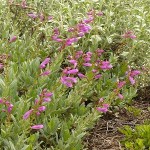
- Barrett's Penstemon
- 5
- Sun or Part Shade
- 12" x 18"
- Eastern Oregon


Waxy blue green leaves and large lavender tubular flowers. Semi-woody structure. Prefers part shade. Firewise.
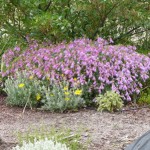
Davidson’s Penstemon is a choice landscape plant with a low, sprawling woody structure that allows it to function like a ground cover. If given some sun protection in winter it will be completely evergreen. Lavender tubular flowers show up in late spring. Likes well-drained soils. Firewise.
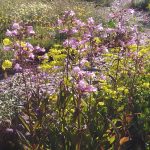
A substantial penstemon with spikes of white to pale pink flowers in June. Unlike most penstemons, it prefers slightly moist, well-drained soil in full sun or part shade. Firewise.
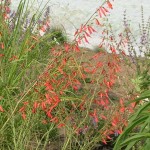
Firecracker Penstemon bears tubular, bright scarlet flowers over dark green basal leaves. Prefers poor to moderately fertile, well drained soil and full sun. Great for dry desert-scapes. Pollinators: hummingbirds and bees. Firewise.
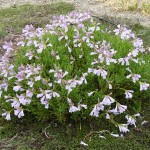
Shrubby Penstemon is an unusual woody, upright, evergreen penstemon with abundant lavender tubular flowers in early summer. Foliage turns soft yellow in autumn with purple-green flower spikelets. Leaves may burn in winter–shade helps. Firewise.
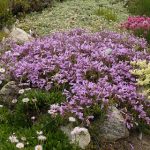
Dwarf Shrubby Penstemon is a compact version of the native Shrubby Penstemon and quite similar to Davidson’s Penstemon. Gorgeous lavender flowers in late spring. Evergreen mounds are beautiful in winter. Charming! Firewise.
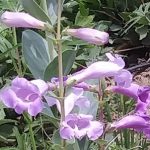
One of the showiest of all North American native Penstemons, Penstemon grandiflorus can reach heights of three feet with stunning pink to purple flowers. The plant’s beautiful vertical structure and succulent gray-green foliage, make it a very unique Penstemon. Firewise. More information here.
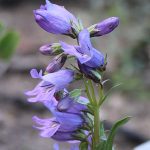
Clumps of bright purple flowers arise from dense tufts of linear leaves. Occurs in the wild at higher elevations in Colorado, but given some irrigation it tolerates cultivation in lower, warmer climates
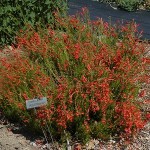
Pineleaf Penstemon has loads of red-orange tubular blooms over expanding clumps of attractive narrow leaves. Stems become woody with age. Evergreen foliage. Firewise. More information here.
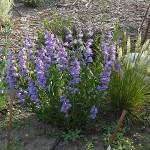
Showy spikes of purple-blue flowers in mid-spring. Flowers are huge and attractive to bees. Firewise.
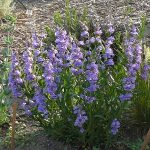
Showy spikes of purple blowers in late spring. The large flowers attract bumblebees.
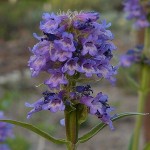
This early blooming penstemon sends up multiple stalks, each with numerous whorls of small tubular flowers. Widespread native. Firewise.
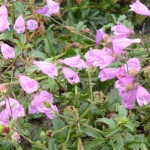
Richardson’s is a wonderful and easy Penstemon for filling in spaces in the garden or tumbling down banks on trailing stems. Unlike most penstemons, this one starts blooming late, producing a charming profusion of rosy purple flowers that lasts from early summer nearly until frost. It re-seeds readily and multiplies in the garden. Firewise.
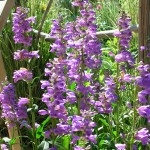
Rocky Mountain Penstemon has violet-blue flower spikes over leathery foliage. Attracts hummingbirds. Long-lived, reliable bloomer. Forms low evergreen clumps, easy and reliable; deadhead for re-bloom. Pollinators: bees. Firewise.
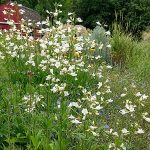
Pure white flowers on tall stems in early summer. This clump-forming penstemon grows wild on dryish soils in prairies and open woods. Attractive to hummingbirds, butterflies and bees.
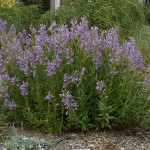
Lovely Penstemon is a vigorous evergreen native penstemon with large, gorgeous tubular lavender flowers in late spring. Cut back seed heads to encourage re-bloom. Pollinators: bees. Firewise.
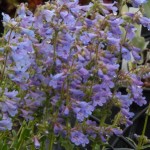
Blue Mist Penstemon or Front Range Penstemon is a dwarf penstemon, native to the plains and foothills of the Eastern Rockies, often growing in large colonies. In late spring, dainty spikes of lavender-blue flowers rise over evergreen rosettes Likes dry, well- drained soil and is well adapted to garden conditions. Firewise.
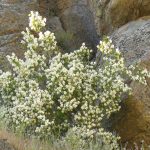
Syringa or Mock Orange is a deciduous shrub with lovely four petaled flowers, incredible fragrance. In the wild, Syringa grows in variety of habitats, from streambanks to lava flows. Can adjust to very low water sites. Idaho state flower. Firewise. More information here.
Shrubby Cinquefoil is a small native shrub covered by small, yellow flowers all summer. Attractive foliage makes this a nice accent plant for sun or partial shade. Attracts bees and butterflies.

Chokecherry has profuse racemes of white flowers that turn into edible black fruit. Leaves turn deep glossy red in fall. Freely suckering growth form provides good wildlife habitat, especially for birds. Pollinators: butterflies, bees. Firewise.
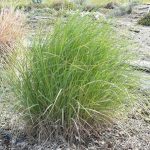
Bluebunch Wheatgrass, a lower Foothills native bunchgrass, greens up early in the spring. Can see out prolifically. Excellent for reclamation, naturalization.
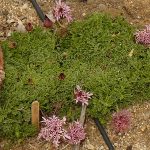
Charming, low-growing rock garden plant or small-scale groundcover. Finely cut evergreen foliage creeps across the ground, sprouting pincushion-like mauve flowers in late spring. Attractive seedhead tufts follow.
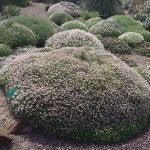
Intricately branched wiry shrublet forming somewhat prickly mound-like cushions. Completely covered with soft pink flowers in late spring.
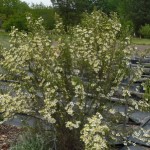
A stout, upright shrub or subtree growing to head-high or higher. Produces many pale yellow, wildrose-type flowers in the spring, each of which produces five feathery plumes with a seed attached. Related to bitterbrush.
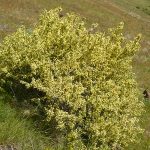
Bitterbrush is a highly branched native shrub often with spectacular yellow spring bloom. Could replace forsythia in native, xeric gardens. Good wildlife habitat. Pollinators: butterflies, bees. Firewise. More info here.
The Gambel Oak is a slow-growing large shrub to small tree., often forming a multi-stemmed thickets, Good accent tree with lovely fall color. Glossy leaves; interesting branch patterns in winter. Firewise.
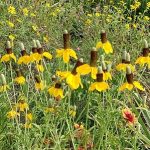
This cheerful wildflower has two forms, one yellow and one red. They both will bloom over a long period in hot, dry summers, attracting bees and butterflies. Great in meadows and other casual landscapes. Will seed around.
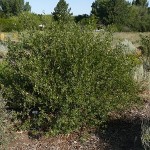
Oakleaf Sumac is a dense, mid-sized to large shrub, excellent foundation plant. Yellow bloom in spring and nice orange-yellow leaf color in fall. Female plants can yield a tart fruit traditionally used to make a lemony drink. Deciduous. Good bird habitat. Unrelated to poison sumac. Firewise. More information here.
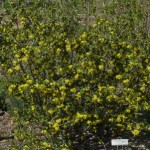
Golden Currant is a deciduous shrub with fragrant, golden yellow flowers in early spring. Small, bright green maple-like leaves with lovely fall color. Widespread in Boise foothills. Tolerates a wide variety of conditions. Firewise. More information here.
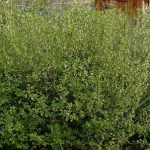
Wax Currant is a dense native shrub well adapted to shade or part shade locations. Small pinkish white blossoms in spring. Good bird habitat. Firewise.
Woods Rose has fragrant, pink rose flowers which profusely bloom. A freely suckering native. Can bloom in full shade as well as full sun.
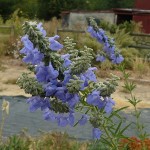
Azure Blue Sage is a tall, late-blooming Salvia. Brilliant blue tubular flowers on slender, arching stems provide dramatic late- season color in the garden. Disappears in winter and comes booming back from the roots in spring. Great late-season food source for bumble bees, honey bees, butterflies and hummingbirds! Tolerates clay. Firewise. More information here.
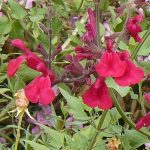
A stunningly beautiful Salvia from high in the mountains of N. Mexico. Attracts hummingbirds, bees. Firewise.
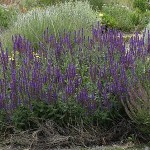
Blue Queen Salvia has spikes of violet-blue flowers in summer; tolerates intense heat and drought. Cut back after bloom for quick re-bloom. Magnet for honeybees and butterflies! Tolerates clay. Firewise.
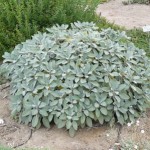
Berggarten Sage is a beautiful and distinctive cultivar of ordinary garden sage valued for its broad, ornamental leaves. Shade tolerant and evergreen with few, if any, flowers. Tolerates clay. Firewise.
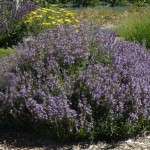
Dwarf Culinary Sage grows into a shrub covered with a dense mound of edible leaves. Covered with showy lavender-blue flowers in early summer, it becomes a magnet for honeybees. Unlike ordinary culinary sage, this dwarf form is completely evergreen, creating a beautiful gray-green mound in the winter garden. Tolerates clay and shade. Firewise.
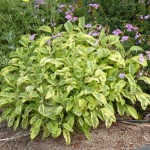
Golden Garden Sage is a variegated variety of culinary sage. Attractive mounds of yellow-green leaves which are shade tolerant and evergreen. Few, if flowers. Use in cooking like garden sage. Firewise.
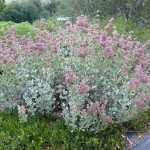
Giant Flowered Purple Sage is a tough, heat-tolerant summer-bloomer with spectacular clumps of deep purple flowers.Attractive gray-green foliage remains in winter. Needs well-drained soil. Attractive to bees, butterflies and hummingbirds. Tolerates clay. More information here.
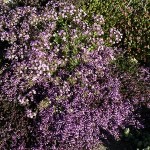
Rock Soapwort is a vigorous, mounding plant, covered with small pink flowers in the spring. Beautiful for edging a sunny border or spilling over rock walls or the edges of large planters. To maintain a compact habit, prune plants back hard immediately after blooming. Firewise.
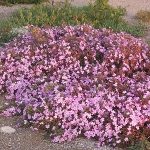
Late blooming, vigorous groundcover with large light purple flowers. Large-scale groundcover. Firewise.